By Graham Mackintosh
Thirty years ago I was in the middle of a two-year quest to walk around the coast of Baja California. Pacific lagoons such as Ojo de Liebre (Scammon’s Lagoon) and Laguna San Ignacio presented special challenges.
Heading north to south and unable to find any fishcamps on the northern shore, I had no option but to walk all the way around Laguna San Ignacio, but I wasn’t inclined to do that with Scammon’s Lagoon.
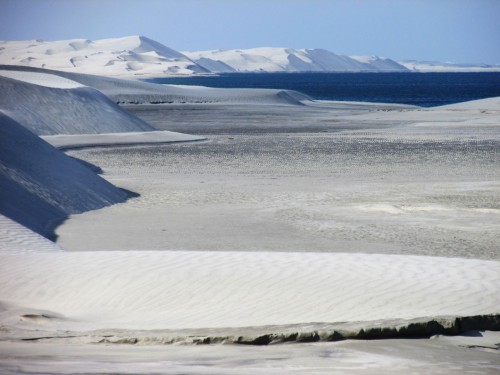 I didn’t want to miss an inch of Malarrimo beach, the famed beachcombing paradise that comprises much of Bahia Vizcaíno, and perhaps most famously stretches from the lagoon mouth 15-20 miles west towards Punta Eugenia. Unfortunately, five miles southwest of Scammon’s, a new lagoon had broken through into the desert creating a miles-deep barrier called Estero Ojo de Liebre on some maps and Laguna Mike McMahan in the Baja Almanac.
I didn’t want to miss an inch of Malarrimo beach, the famed beachcombing paradise that comprises much of Bahia Vizcaíno, and perhaps most famously stretches from the lagoon mouth 15-20 miles west towards Punta Eugenia. Unfortunately, five miles southwest of Scammon’s, a new lagoon had broken through into the desert creating a miles-deep barrier called Estero Ojo de Liebre on some maps and Laguna Mike McMahan in the Baja Almanac.
Even though I was not sure I could get around that new lagoon, the siren call of Malarrimo couldn’t be resisted. Wearing the boots of a man killed in Scammon’s Lagoon when his boat collided with a gray whale, I hitched a ride in a panga and was dropped just inside the western entrance to Scammon’s. It was high tide. Blinding white dunes lined the shore. I struggled alone, sometimes calf-deep in the alarmingly soft sand, to make my way around to the firmer beaches and rolling thunderous waves of the open ocean.
Malarrimo was not a disappointment; the beachcombing was indeed fantastic. The story was told in my book, Into a Desert Place:
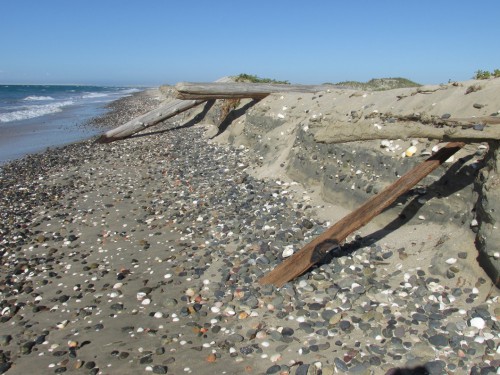 “It was as if some terrible and destructive battle had taken place off the coast. The shore was littered with planks, buckets, tree trunks, helmets, hatch covers, bits and pieces of boats and planes, and all kinds of military and medical equipment.” Into a Desert Place
“It was as if some terrible and destructive battle had taken place off the coast. The shore was littered with planks, buckets, tree trunks, helmets, hatch covers, bits and pieces of boats and planes, and all kinds of military and medical equipment.” Into a Desert Place
But with just three gallons of water I hardly had time to take in a fraction of what was around me. I was driven by the thought that unless I was prepared to risk a 10-mile detour through swamp and mangroves and more strength-sapping soft dunes, or build a raft from all the driftwood, I had no idea how I was going to cross the wide mouth of that new lagoon. In the end, I was able to get over using an old aluminum boat that I found just inside the lagoon’s entrance. It was upside down, under water and full of holes.
As part of the 30th anniversary of my walk, with a new book in mind, I’ve been returning to some of the special, mostly remote, places in Baja to see how they have changed. And above all, I have always wanted to get back to that remote section of coast between the lagoons and walk it again with more time to beachcomb and ponder the natural and historical wonders beneath my boots.
Today that area is just a tiny part of the largest protected zone in Mexico, indeed in all of Latin America – the El Vizcaíno Biosphere Reserve. Established in 1988, the reserve includes hundreds of kilometers of the Pacific coast and the Sea of Cortez, and much of the desert between. It includes the habitat of the endangered pronghorn antelope, as well as the world renowned sites of Laguna Ojo de Liebre and Laguna San Ignacio, and the cave painting treasures of the Sierra de San Francisco.
The Vizcaíno Biosphere Reserve is administered and managed by CONANP, the National Commission of Natural Protected Areas. Their headquarters is in Guerrero Negro. So thirty years on, in July 2014, after explaining my intentions to the officials at CONANP and reassuring them that I had no intention of using any motorized transport on the beach, I secured permission to return again to Malarrimo. They not only graciously granted it, but arranged a panga ride across the wide mouth of Laguna Ojo de Liebre and kindly offered every assistance to get there and return safely to town.
I went in the company of longtime friend and Discover Baja member Peter Jensen. And I couldn’t have wished for a more knowledgeable companion. He is a Baja shipwreck historian who for over 30 years has discovered, researched, and collated extensive files on over 1000 shipwrecks along the Baja California coast.
We both bought Annual passes, “pasaportes,” there at the CONANP office, which not only granted us a full year’s access to the Vizcaíno Biosphere Reserve but also to visit all the parks and protected areas of Mexico – for a very reasonable cost of about $29 US.
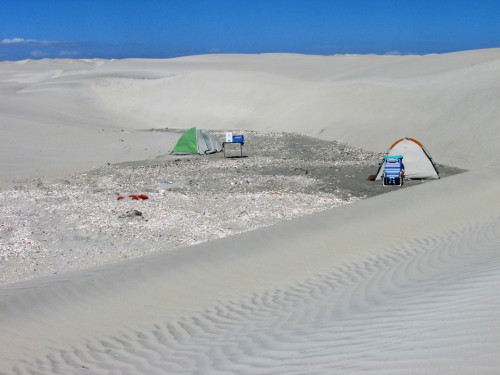
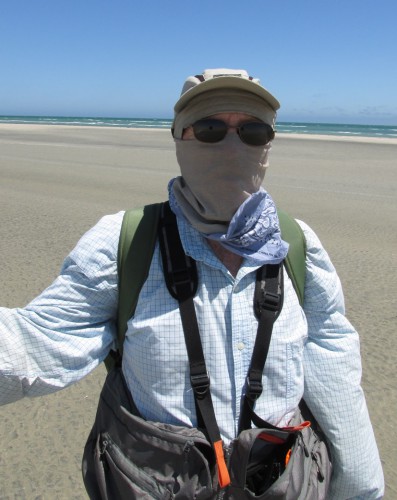 I was nursing a strong sense of déjà vu when we landed at about the same spot that I did all those years ago, just inside the lagoon, this time at low tide. Peter and I arranged to be picked up in a week and quickly moved our gear off the beach and made camp among the dunes. I had a SPOT GPS messaging device to assure our families and the folks at the CONANP office that all was well.
I was nursing a strong sense of déjà vu when we landed at about the same spot that I did all those years ago, just inside the lagoon, this time at low tide. Peter and I arranged to be picked up in a week and quickly moved our gear off the beach and made camp among the dunes. I had a SPOT GPS messaging device to assure our families and the folks at the CONANP office that all was well.
The snow-white, talcum-powdery-soft dunes were still there, making for tiring walking. The wind was still relentless. Camping in the protection of the dunes might seem like a good idea… till sheets of fine sand begin covering tent floors, sleeping bags, pots and plates and anything else left exposed. I took three Canon point-and-shoot cameras out with me. Only one survived the insidious assault of the blowing sand.
Camping anywhere around the entrance to Scammon’s Lagoon presents some of the most challenging camping anywhere in Baja. With no vegetation more than a couple of inches tall there is absolutely no shade. Coyotes visit every night and are happy to relieve you of anything left out, especially water. And when the wind relents, biting horseflies seize the chance to munch on your legs.
To compensate – the Pacific beaches are wide (at least at low tide) and strikingly beautiful, summer temperatures are generally tolerable, and can seem downright cool when the prevailing 15-20 mph NW winds are still gusting after sundown. The bird life was abundant and pods of dolphins patrolled offshore, sometimes bursting into the shallows and chasing fish right on to the beach.
Maybe beachcombing was not as dramatic as in the glory days when Malarrimo was regarded as the inevitable final destination for just about anything that would float that had been cast into the Northern Pacific.
Today, Malarrimo makes you work hard for every discovery. One needs to sift through a prodigious amount of modern trash, especially plastic containers, glass bottles and jars, light bulbs, deflated party balloons, and even rusting fridges!
And sadly, there were a number of empty blue plastic gasoline barrels, in otherwise new condition that had been deliberately slashed. No doubt these had been thrown overboard by drug runners not wishing to leave a too obvious trail of tossed containers marking their route north.
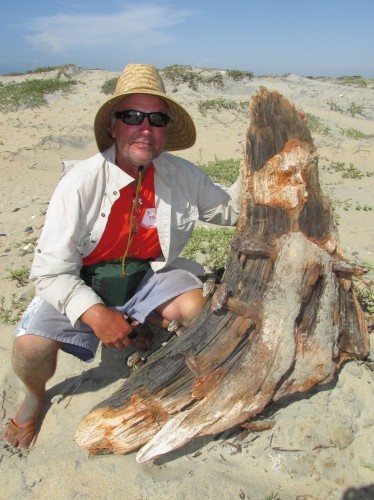
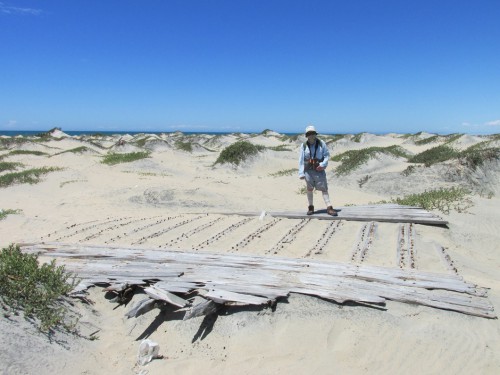
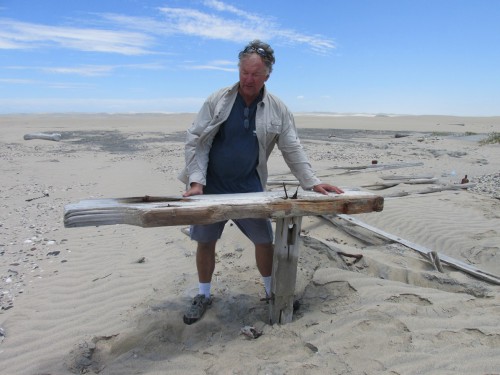 Even so, it remains endlessly fascinating. Dead whales and dolphins and huge tree trunks abound. And the ever shifting dunes – we measured the one next to our campsite moving an inch a day towards us – guarantee there is always something “old” for the discerning eye to see.
Even so, it remains endlessly fascinating. Dead whales and dolphins and huge tree trunks abound. And the ever shifting dunes – we measured the one next to our campsite moving an inch a day towards us – guarantee there is always something “old” for the discerning eye to see.
Back in 1983 I had spotted a piece of wreckage, the wooden hull of a sailing ship covered with copper sheathing stamped, “Shears of London.” We looked for more of the wreckage to confirm if this ship might have been the Toward Castle, a British whaling vessel that went aground on that section of beach in 1838.
The Master, Chief Mate, and five of the crew were saved. They had taken to the ship’s lifeboat to find help. Those that stayed behind on the remote beach died of thirst and exposure before their crewmates returned. In his writings, Captain Scammon mentioned the wreck and finding the log book, and using some of its timber to fuel fires for rendering his take of whale blubber into oil.
We found plenty of evidence of nineteenth-century vessels, including sections of deck and sturdy “knees” (massive L-shaped brackets cut out of tree stumps that once held up the deck), and an assortment of masts, booms and spars.
Thanks to Peter’s expertise, especially his discovery from delving into the Lloyd’s archives that the Toward Castle had indeed been refitted and re-sheathed with copper in London in 1835, and Scammon’s account of the location of the wreck, we were very confident that some of the remains did come from the Toward Castle, which was named after a castle in Scotland.
On July 4, we walked to the mouth of the new lagoon that had caused me so much concern thirty years earlier. The passage was several hundred yards wide. I marveled that I had been bold enough to row across in a sinking boat using a piece of driftwood as a paddle! It was partly desperation – I didn’t want to share the fate of the unfortunate crew of the Toward Castle – and partly being encouraged by finding a message in a bottle… a religious tract entitled Help from Above!
And reward for my faith, I recalled that within minutes of reaching the far side I stubbed my toe against a full bottle of Japanese whisky.
On this trip Peter and I did spot bottles of Japanese whisky and sake (unfortunately empty) and crates from Tokyo and Osaka, but perhaps nothing indicative of the vast amount of material from the recent tragic tsunami in Japan. That has clearly yet to arrive.
And it was fitting that as we stood ankle-deep in the soft sand at the mouth of the lagoon, as I gave thanks for the good fortune I’d experienced there all those years before, lightning flashed and thunder boomed from a summer storm billowing on the other side.
It was yet more of the magic of Baja… we were being treated to our own special Independence Day fireworks show.
Graham Mackintosh is the author of “Into a Desert Place: a 3000 mile walk around the coast of Baja California” and three other adventure travel books on Baja California. For more information see: www.grahammackintosh.com

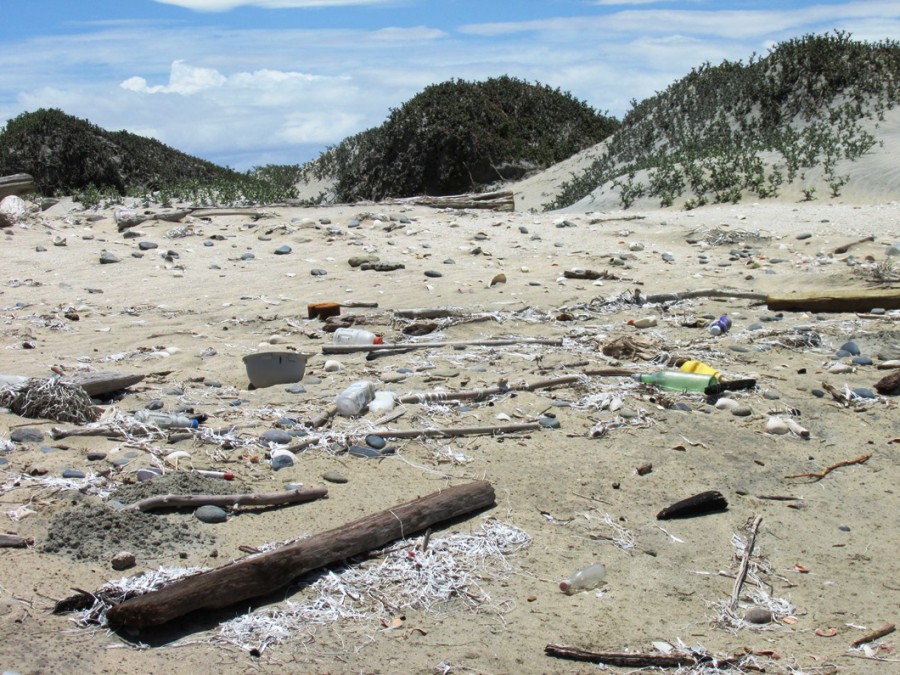
Yes, I love the bar in Guerrero Negro called Malarrimo. It has so many wonderful artifacts taken from the beach. I have always wanted to go, but have been highly discouraged from anyone in the hotel.
Just went there with three other guys on off road bikes. Took couple hours on 24 mile windy ride. Two coyotes fighting on the beach over a female just as we arrived on beach. Rescued very tired hungry juvenile coyote down beach with a plastic jar stuck firmly on his head for how long no idea. Had to cut it off with knife. He ran off to live another day. Old whale bones sticking up out of beach. No beach treasures but a great isolated stretch of beach I’ve always wanted to see
What did the coyote do while you were cutting the plastic jar off his head? Was he scared? Fierce? Too tired to resist?
What did the whale bones look like? Vertebrae? Ribs? Skull? Pectoral fins? Were there a lot of whale bones? Any glass floats from Japan? Could you see Gray whales offshore swimming by? All in all, was it worth it? From Guerrero Negro, howling did it take you to get out to Malarrimo beach? Did you pass or see anyone on that graded dirt road to the beach? Thanks. Sorry for all the questions. Thinking of doing it with a buddy in March in a 4×4 SUV.